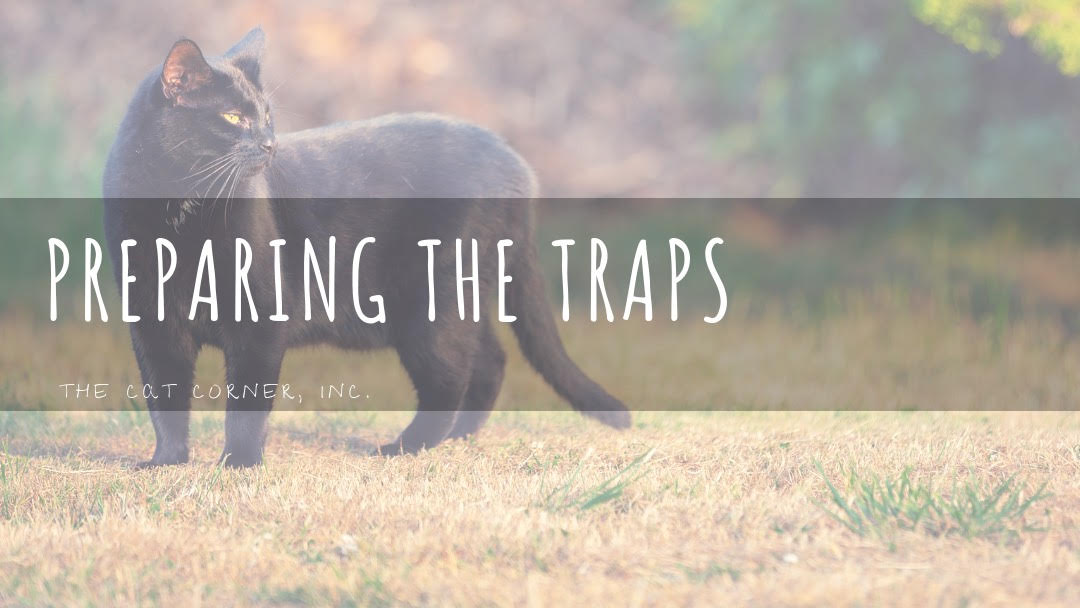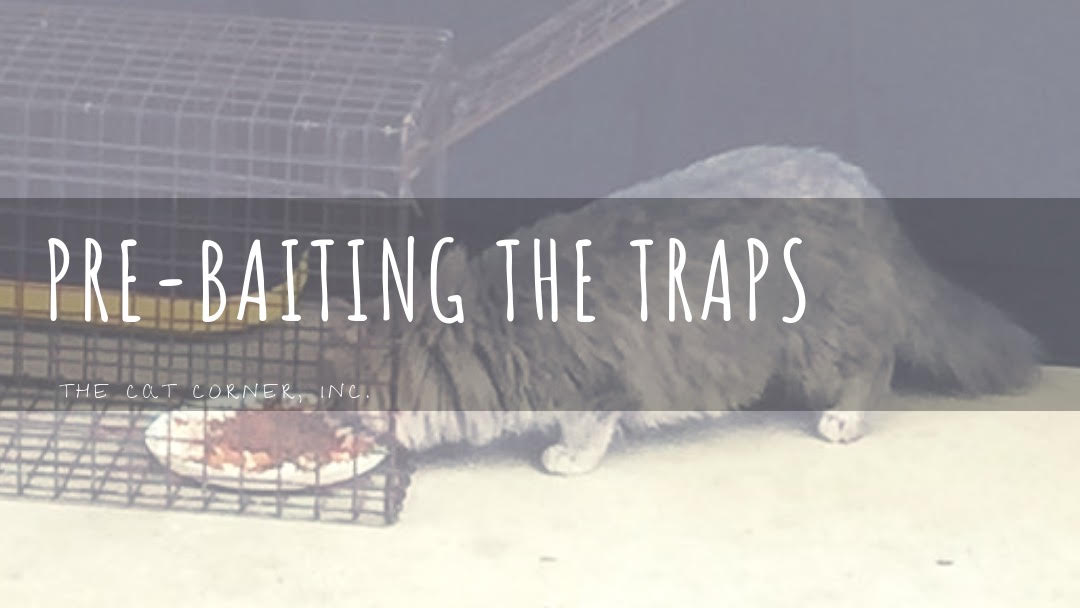Before You Begin
- The first step is to get the cats used to being fed at the same place and same time of day. Early morning or at dusk are the best times for trapping, but the cats will learn to come at whatever meal time you set for them. Consistency is important.
- Plan to set the traps and catch the cats on the day before your spay/neuter clinic appointment. If the cats have been consistently eating in the traps each day, it is not necessary to withhold food; just use the regular food at the regular time. Never leave a trap set overnight and do not trap without having a spay/neuter appointment.
- Do not “set” the trap and practice “trapping” the cat days before your scheduled appointment. It is much harder to trap the cat a second time. Be careful not to “set” the trap when training the cat to eat in the trap. (Refer to pre-baiting trap section). Click here for spay/neuter clinics that offer Feral Packages to public at free or discounted rates.
- Do not trap in the rain or the heat of the day without adequate protection for the traps and be present so you can move the cats as soon as they are trapped.
- Prepare the area where you will be holding the cats before and after the clinic. A garage, laundry room, bathroom or other sheltered, warm, protected area is best. Lay down plastic sheeting or a tarp, covered with newspapers to absorb any mess. You can use pieces of wood to elevate the traps off the newspaper to allow the mess to fall through and away from the cats. Prepare the vehicle you will use to transport the cats in the same way with a tarp and newspaper.
Preparing the Traps to be Set
- Line each trap with newspaper. A couple sheets of the daily paper folded lengthwise make a perfect trap liner. This keeps the cats from having to walk on the wire, and will help absorb any mess the cat makes while in the trap.
- Each trap must be covered with a towel or other piece of fabric large enough to completely cover the trap. Keep the trap covered at all times. This will reduce stress on the cat and keep him/her calm. Make sure you have a spay/neuter appointment on the following day, and have your holding recovery area and car prepared.
Pre-Baiting the Traps
- Feeding the cats in the trap prior to setting the trap is called “pre-baiting”. This is a very important step in the trapping process. Optimally you would pre-bait the traps for 4 to 5 days prior to trapping.
- Place the traps in the area where you normally feed the cats. · If using an FCCO double-door trap, remove the back door. For a one-door trap, securely wire or zip-tie the door into the open position.
- Feed the cats at a time when you will be available to monitor the traps.
- Place the food on a small paper or plastic dish at the far end of the trap so the cat has to go all the way into the trap. Be sure the cat does not have access to the food from outside of the trap. Do not put food anywhere other than inside the trap during this process.
- Use the cats’ regular food, only leave enough for the cat(s) you are intending to catch, and pick up what is left after each meal. Do not leave food in the traps all day or night; this will encourage animals that are not your targets, such as neighbor cats and wildlife.
- Once you start this pre-baiting process, do not put any food outside the traps; the cats are learning that it’s necessary and safe to go into the trap to eat. Several days of pre-baiting are ideal, but even one or two days will be helpful.
Setting the Traps
- On trapping day (the day before your appointment), set the traps just before the cats' normal feeding time. If trapping in a public area, try to place the traps where they will not be noticed by a passerby who may not understand what you are doing.
- Replace the door to the trap, and latch it. To latch the trap door securely, place the hasp (oblong metal piece which is on the bottom of the trap door opening) over the piece of metal the latch goes through on the door. Once the hasp is in place, place the latch through the metal piece and make sure it is closed.
- To set the trap, open the trap door by pushing the top of the door in and pulling the bottom of the door upward. There is a small hook attached to one side of the trap top. It hooks onto a tiny metal cylinder on the right side of the door. The hook holds the door in an open position which also raises the trip plate. When the cat steps on the plate, it will cause the hook to release the door and close the trap.
- Cover the trap with a towel, leaving both ends uncovered, and set it in the area where the cats eat.
- Make sure the trap is on solid, level ground. If necessary, use another towel under the trap to make sure it doesn’t wobble.
Waiting for Success
- Never leave traps unattended. The trapped animal is vulnerable and could get injured inside the trap, or a passerby could release the cat, steal the trap, or both.
- Wait quietly in an area where you can still see the traps without disturbing the cats, but not where the cats can see you. Your car or house window work very well. Check the traps every 15 to 30 minutes; you can usually hear the trap door closing. As soon as a cat is trapped, quickly cover the trap completely and remove it from the area. When carrying the trap always use the handle on top of the trap. Do not use the handle for the door in case it is not latched properly. If you are trapping multiple cats, repeat this process until all cats are trapped.
- When you get the captured cat to a quiet area away from other traps, lift the cover and make sure you haven’t trapped a pet or previously neutered feral (look for an ear tip). There is a chance of catching a wild animal or an unintended cat attracted to the food in the trap. If this occurs, smply release the animal as described in the releasing instructions, and then reset the trap.
Recovery
- When you pick up the cats from the clinic, they will still be groggy from their anesthesia.
- Keep the Surgery Post Surgery Care Instructions form that you received when you picked up the cat. All of the information you need to know about what to watch for is on this form. This form is also your record of the services the cat received that day.
- The cats will spend a night in the traps in the area you have prepared for them to recover, and be released the next day in the same area where they were trapped.
- Do not transfer the cat from the trap to a carrier. The cats actually do better in the trap and it’s cleaner for the cat as well.
- Feed the cat the night you pick them up from surgery if they are sitting up, and again in the morning before release. Place a small amount of canned cat food (1/4 can) on a paper plate. Place the trap over the food so the cat can reach the food without you opening the door of the trap.
- Do not open the trap until the next morning when the cat is being released. The only exception to this is to slip some food into the trap once the cat is at home in their recovery area if you can do this safely, without letting the cat escape. If possible have someone else distract the cat while opening the door an inch. Cats will try to escape out of small openings, so it’s best to only open the trap as a last resort to feeding the cat.
- Do not place a water dish in the trap, feeding canned food gives them the moisture they need for the time while they are in the trap.
- It is best if the cat eats before he or she is released, but do not be concerned if the cat is not interested in the food. Sometimes they are too scared and stressed to eat.
- All cats recovering from anesthesia are unpredictable and should be kept quiet. Even if this is a tame stray, do not open the trap door or attempt to handle the cat. This can have serious consequences such as the cat getting loose in an area that is not familiar to them, injury to the cat or injury to you.
- If a cat does try to escape do not try to grab him/her by hand. These cats will not hesitate to bite or scratch you in this situation.
Returning the Cats
- Do not release the cats to an area where they were not trapped. This is dangerous for the cats. Relocating cats safely to a new location requires additional preparation.
- When ready, turn the latched door away from you, unclip and remove it, and let the cat run out.
- NEVER PUT YOUR HAND IN THE TRAP. If the cat does not go out immediately, walk away from the trap and watch from a distance until the cat leaves the trap.
Lactating Females and Kittens
- If you capture a lactating female, check the area for kittens and remember that this female must be released 10-12 hours after surgery so she can care for and nurse her kittens. A lactating female will continue to make milk after being spayed and can return to nursing kittens.
- Females with kittens will be attracted by the sounds of their kittens, if the previously captured kittens are placed in a covered carrier just behind the trap. Similarly, kittens will be easier to trap if the previously captured mother is in the carrier. Place the door of the carrier facing the rear of the covered trap. Never place the "bait" animals in the trap or anywhere they may be harmed by the trapped animal.
- If kittens are trapped, they can be tamed. For information on taming feral kittens go to the Alley Cat Allies website at www.alleycat.org/resources_care.html and scroll down to Homing Feral Felines.
General Precautions
- Any bite or scratch should be taken seriously- seek medical attention immediately. If possible, DO NOT RELEASE the cat. The cat must be quarantined. Contact the animal control agency in your area for quarantine instructions.
- For your safety: Do not put your fingers into the trap at any time, always pick the trap up by the handle on top of the trap. Keep children and pets away from the cat at all times during the trapping and recovery process.
|
Copyright 2014
|









